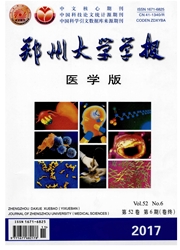

 中文摘要:
中文摘要:
目的:观察Toll样受体(TLR)在大鼠大脑分化和成熟过程中表达的变化。方法:取妊娠16、18 d的胎鼠和新生鼠(n=10)的大脑皮层,用抗体荧光染色检测Ki-67和Neu N阳性细胞百分比,同时用实时荧光定量PCR和Western blot法检测TLR的表达。结果:随发育的进展,大鼠大脑皮层中Neu N和Ki-67阳性细胞百分比逐渐降低(P〈0.05),TLR1、TLR2、TLR3、TLR4、TLR7和TLR9的表达逐渐升高(P〈0.05),而TLR5、TLR6和TLR8的表达无明显变化(P〉0.05)。结论:TLR可能参与了神经前体细胞的分化和成熟。
 英文摘要:
英文摘要:
Aim: To observe the changes of Toll-like receptor(TLR) expression in the differentiation and maturation of the rat brain. Methods: Cerebral cortex of fetal rats of 16 and 18 days and neonatal rats(n = 10) were collected to detect Ki-67 and NeuN by fluorescent antibody, TLR expression by real-time PCR and Western blot method. Results: With the development of the progress, the percentages of NeuN positive cells and Ki-67 positive cells in the rat cerebral cortex de- creased gradually(P 〈 0.05), the expressions of TLRI, TLR2, TLR3, TLR4, TLR7 and TLR9 increased gradually( P 〈 0.05 ) , while the expressions of TLRS, TLR6 and TLR8 had no significant changes(P 〉 0.05). Conclusion : TLR may be involved in the differentiation and maturation of neural progenitor cells.
 同期刊论文项目
同期刊论文项目
 同项目期刊论文
同项目期刊论文
 Elevated Serum Levels of Neopterin at Admission Predicts Depression After Acute Ischemic Stroke: a 6
Elevated Serum Levels of Neopterin at Admission Predicts Depression After Acute Ischemic Stroke: a 6 期刊信息
期刊信息
